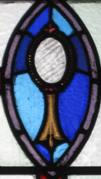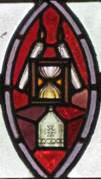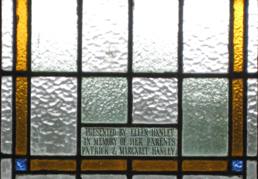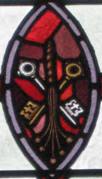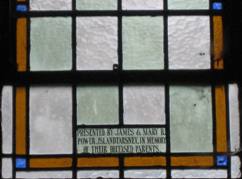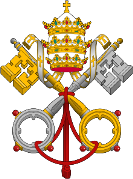The fifth nave window
We are unsure as to exactly what this window detail is showing. It could be a small casket or a large chest. It doesn’t look like an altar. Could it be the Ark of the Covenant? –
“They shall make an ark of acacia wood. Two cubits and a half shall be its length [a cubit was about 18 inches or 45 centimetres], a cubit and a half its breadth, and a cubit and a half its height. You shall overlay it with pure gold, inside and outside shall you overlay it, and you shall make on it a moulding of gold around it. You shall cast four rings of gold for it and put them on its four feet, two rings on the one side of it, and two rings on the other side of it. You shall make poles of acacia wood and overlay them with gold. And you shall put the poles into the rings on the sides of the ark to carry the ark by them. The poles shall remain in the rings of the ark; they shall not be taken from it. And you shall put into the ark the testimony that I shall give you [the two stone tablets bearing the ten commandments].
“You shall make a mercy seat of pure gold. Two cubits and a half shall be its length, and a cubit and a half its breadth. And you shall make two cherubim of gold; of hammered work shall you make them, on the two ends of the mercy seat. Make one cherub on the one end, and one cherub on the other end. Of one piece with the mercy seat shall you make the cherubim on its two ends. The cherubim shall spread out their wings above, overshadowing the mercy seat with their wings, their faces one to another; toward the mercy seat shall the faces of the cherubim be. And you shall put the mercy seat on the top of the ark, and in the ark you shall put the testimony that I shall give you. There I will meet with you, and from above the mercy seat, from between the two cherubim that are on the ark of the testimony, I will speak with you about all that I will give you in commandment for the people of Israel”. [Exodus 25:10-22].
The window detail is grey in colour instead of golden, has no rings or poles, no feet, and no mercy seat or cherubim. So it’s unlikely to represent the Ark. (See also the sixth south transept window).




